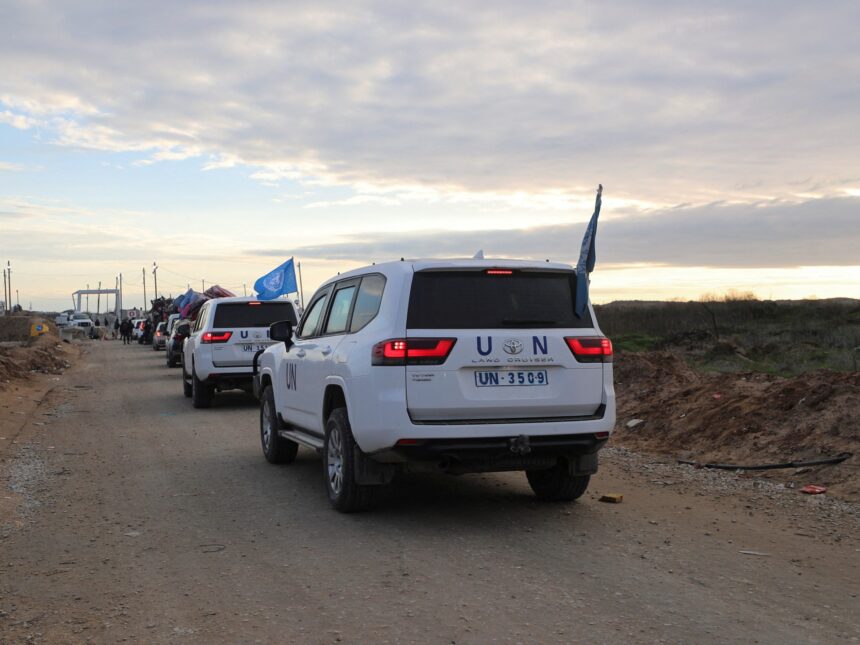In recent weeks, the demands for deployment of a protective force in Gaza and the West Bank have resurfaced. They have come from health professionals and medical organizations, Palestinian NGOs and even Arab civilians. Last year, organizations of the Arab League and human rights also requested a peacekeeping force that is sent to Gaza.
In the light of the global normalization of live genocide and the political reluctance to enforce international law, this demand represents a minimum measure to safeguard the Palestinians against unimagnerable horrors.
Demand is firmly based on international law. In Gaza, a peacekeeping force could advance in the duty of the United States and nations to protect a people who face genocide, war crimes and crimes against humanity under investigation in the International Court of Justice and International Criminal Court. Both in Gaza and the West Bank, such forces could support the process of ending the occupation, as required by the UN General Assembly and the International Court of Justice.
And yet, the demand for a protective force faces important challenges. The crucial question is: can they be overcome?
The justification for a protective force
The situation in Gaza and the West Bank has reached unprecedented urgency and limb. The military pressure of the armed groups in Lebanon and Yemen exerted in an attempt to protect the Palestinian people failed to stop atrocities, and the Lebanese and Yemeni people have a heavy price.
That is why an international protective force is urgently needed. Its deployment would fulfill what the Palestinian population is asking the international community to do: protect them. This force would serve as a “human shield”, not in the derogatory sense armed by the Israeli army to justify its genocide by frameting the entire Palestinian population as human shields, but in the sense of a literal pea a literally interwoven.
Its presence could mean the difference between life and the death of the mass for civilians who have faced a year and a half of bombing, siege and starvation.
In addition, this force sacrifices a critical alternative to the most sinister “solutions”. As Israel intensifies its genocidal campaign, imposing conditions designed to destroy the Palestinian life, the United States has presented the idea of deploying its troops to Gaza to “assume it.”
Such movement would constitute an illegal invasion of Palestine, further strengthening colonial violence under the appearance of maintaining “stability.” On the contrary, the forces in charge of the response to protect the Palestinians, and not the imperial and colonial interests could provide a legitimate and international countermeasted.
The challenges of forming a protective force
The deployment of protection forces through a UN mandate requires a resolution of the UN Security Council. Definitely, the United States will veto any attempt to create such force, just as it has rejected several resolutions of high fire, in fact it allows genocide and blocking any effort to defend even the most basic principles of humanity under the UN Letter.
Undoubtedly, the situation is growing more desperately under an American administration that actively supports the expulsions and mass deportations of the Palestinian population of Gaza. The president of the United States himself, Donald Trump, described the Gaza Strip as a “demolition site” and expressed his desire for the United States to make him the “Riviera del Middle East.”
Since a resolution that asks for a protective force will be blocked in the Security Council, the alternative is a multilateral call to action through the UN General Assembly. Also there, the American coercive power greatly influences the votes, including that of the Palestinian authority, but remains a viable option. The first movement that could happen is in the next session of the General Assembly in May and would require immense diplomatic pressure.
A vote for a protection force by the General Assembly would not be binding and would require by the Security Council. However, it could help create a coalition of countries that indicate their willingness to intervene with concrete protection measures in defense of Palestinian life after 19 months of emptiness without tangible actions.
Another challenge is that the mechanism of deploying peace maintenance forces has been considered with suspicion by states in the global south, and for a good reason. The UN Peace Maintenance Troops have often served as surveillance tools in the global south and as experimental control, sometimes committing atrocities themselves.
Historical, the maintenance of peace has been largely aligned with imperial interests, it rarely opposes them. Countries that contribute to troops have questionable military alliances, and peace maintenance operations depend on the financing of large donors, such as the United States. A good example of this is the Mission of Maintenance of the Peace of Unifil in Lebanon, which has an unusually high European presence and has not been able to protect the country from the country from Israel’s aggression.
Given all these challenges, do we abandon the demand for a protective force in the occupied Palestinian territory? At all.
A radical reinvention of protective forces
Obstacles are real, but the demand for a protective force is legitimate. It comes from multiple sectors of the Palestinian society itself and is supported worldwide by individuals and antigenocidal groups.
In a recent request, Palestinian and international health workers propose a model: a neutral multinational protection mission, not mediating, but to protect. Their demands include excluding current nations in the assault of contributing troops and a mandate for the protective force physically protecting Palestinian civilians and health workers, to restore humanitarian and safe humanitarian corridors, already supported. Palestinian-llan of plain plain plain plain -Led-lled-led-led-led-led-led-led-led-led-led-led-led-led-led-led-led-led-led-led-led-led-led-read-read-read-read-right
Similarly, the NGO Palestinian network has requested international protection, open crossings to Gaza and guaranteed safe aid corridors.
Meanwhile, Egyptian civilians have repeatedly declared their preparation to enter Gaza as a civil protection force if the borders are open. This underlines the potential for the protection of people together with formal mechanisms.
To translate multiple calls into action thesis, a radical reimagination of how a protective force could be required and how it could work.
First, we need states not to participate in genocide and civil society groups to boost the UN Security Council. They must focus all efforts and take advantage of the special emergency session of the UN General Assembly in May to face the pressure of us and press for voting on a peace maintenance mandate.
Second, we need new south-south alliances. This means strategic associations between the nations of the Global South not involved in the genocide to finance and personnel of a free influence free mission that can be successful even with the permission of the Security Council.
Third, we need an unprecedented mobilization of civil society in one direction: to press governments to support and participate in a truly neutral protective force.
The United States would oppose the creation of new coalitions that focus the Palestinian life and present themselves as the southern champions of the responsibility of protecting doctrine. He would see this as the challenge of his hegemony and the Western monopoly on the antigenocide speech, and would use his veto at the counter. However, countries and civil society groups involved in the establishment of protective force should ignore the veto, form the autonomous mission and challenge the genocidal international order in which we live.
The challenges that face this radical reimagination effort are formidable. But the alternative is to continue leaving unprotected Palestinian lives, at the mercy of an intense process of colonial colonial extermination. We must act now and press by a protective force for occupied Palestine.
The opinions expressed in this article are those of the authors and do not necessarily reflect the editorial position of Al Jazeera.




